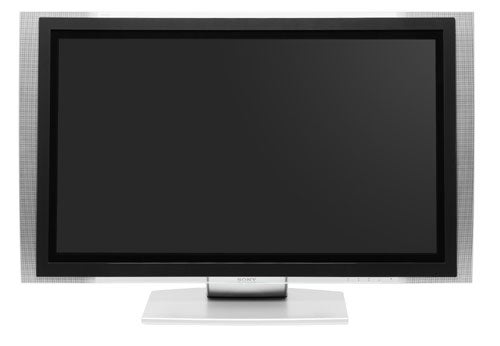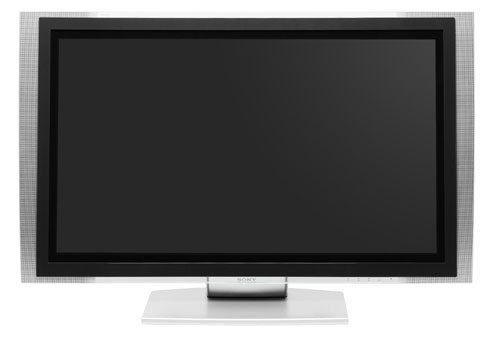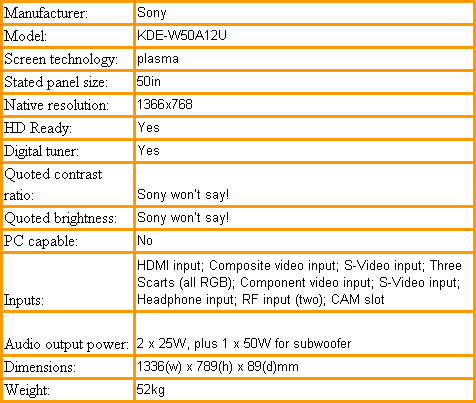Sony KDE-W50A12U 50in plasma TV Review
Sony KDE-W50A12U 50in plasma TV
Sony is pulling out of the plasma market, but does this last screen make a fitting legacy?

Verdict
Key Specifications
- Review Price: £3800.00
In case you haven’t heard, the KDE-W50A12U is the last plasma TV Sony is ever going to build. The Japanese megacorp announced recently that it was now going to focus exclusively on LCD. So let’s just hope that Sony’s plasma swansong turns out to be more a fond farewell than a case of good riddance…
The fond farewell option certainly seems more likely from the way the TV looks. It’s truly a sight to behold with its sexy see-through glass strips to top and bottom, and bold blend of black and silver elsewhere. In fact, even though the set is already over 50in across, the design is so nice that we could happily have lived with even more of it!

This style-meister’s connectivity is mostly good, with one big disappointment. The good stuff includes HDMI and component sockets for digital and analogue HD sources respectively, three SCARTs (all of which, superbly, can take top-quality RGB signals), and a slot via which you can add subscription services to the set’s built in digital tuner. The bad news is that there’s no sign of any PC connectivity, shattering our dreams of playing World of Warcraft on a 50in scale. This really does seem a bit of an oversight on what is, after all, one of the costliest 50in plasma TVs in town.
As you’d expect of a big flat panel TV costing in the region of £4k, the W50A12U is fully HD Ready, with its native pixel resolution coming in at 1,366 x 768. It can also handle the key HD format duo of 720p and 1080i, though 1080p is not an option.
A quest for more features starts with the digital tuner we mentioned earlier, a tuner that’s backed up, we’re happy to say, by support for the Freeview 7-day electronic programme guide. What’s more, you can filter the listings in this EPG according to genre, and immediately set recording events simply by selecting desired programmes in the listings.
The W50A12U also boasts Sony’s ‘Wega Engine’, a picture processing system that, among other things, works to reduce video noise, increase the perception of detail, and scale incoming sources to the panel’s native resolution entirely digitally.
If like us you ran up some horrendous electricity bills over the past, freezing cold winter, you might also appreciate the W50A12U’s unusual power saving mode, whereby the picture’s brightness is reduced to preserve power and, potentially, extend the plasma panel’s life. We only say you ‘might’ appreciate it though, since for our money, the reduction in brightness the power saving mode causes goes too far for comfort.
Perhaps the last truly interesting feature of the W50A12U concerns its sound, as unusually for a flat-panel TV it sports a built-in subwoofer for – hopefully – providing the sort of bass levels so typically missing from flat-panel speakers.

Put to work on every type of source we could get our hands on, the W50A12U occasionally delivers quite stunning results. But it also occasionally looks pretty average…
Its most consistent strength is its colour response. The sheer range and vitality of the colour hues on offer is outstanding, and really reaffirms one of plasma technologies key advantages over LCD. That said, it will be interesting to see if the new ‘wide colour gamut’ technology Sony is introducing to its upcoming LCD TV range redresses the balance – keep checking this site for reviews of those LCDs soon.
Colours as good as those of the W50A12U are usually accompanied by a wide-reaching contrast range, and so it proves here. Particularly convincing is the TV’s rendition of black, which avoids almost completely the flattening greyness that besmirches dark picture areas on many rival flat panel TVs – especially LCD ones. Even better, dark picture areas don’t look empty or over-dominant thanks to the appearance of uncommonly subtle shadow details and colour gradations.
The W50A12U can also produce outstanding (by plasma standards) amounts of fine detail and sharpness. This is especially evident while playing an Xbox 360, as the lush landscapes of Elder Scrolls: Oblivion and Kameo, plus the lightning fast freeways of Burnout Revenge, all look so good it brings tears to your eyes. But HD movies also look impeccably sharp and three-dimensional.
Unfortunately, while the W50A12U is happy as Larry with HD stuff, it gets a bit grumpy when asked to show anything less immaculate. Perhaps the biggest single problem is that, WEGA Engine or no WEGA Engine, it exaggerates any digital blocking noise that might be in a source, be it pictures from its own digital tuner, a connected Sky Digital receiver or even some lower-quality DVDs. This can even apply to DVDs you’ve upscaled from standard to high definition using an upscaling DVD player. Another curious glitch is that the TV tends to make contoured edges within a picture look unusually jagged.

We were disappointed, too, during standard definition viewing to see signs of three traditional plasma picture problems that we’d really expect Sony to have got rid of by now. First there’s grey and green ‘fizzing’ in dark backgrounds – a problem usually associated with screens that aren’t adept at keeping electrical charge out of plasma pixel cells that are supposed to be dormant, in order to appear black. Second, motion processing noise means that objects moving across the screen can appear as if they’re covered in a seething mass of flies. And finally, what should be subtle colour blends sometimes appear as rather clumsy stripes.
The W50A12U is much more consistent sonically. Thanks to its use of Sony’s acclaimed S-Master digital amplification technology and built-in subwoofer, the W50A12U’s audio is outstanding, rising effortlessly with almost hi-fi prowess to meet the challenge of every action movie or pop video challenge we threw at it.
”’Verdict”’
Overall, although it’s not a bad TV by any means, it is nonetheless quite easy to see from the W50A12U why Sony has decided to abandon plasma. Sure, the TV looks great and eats high definition for dinner. But standard definition viewing highlights a few fairly fundamental issues that Sony still hasn’t addressed, while the price just isn’t low enough to really be competitive.
In the end we’re mostly left hoping that Sony’s decision to withdraw its efforts from plasma means it has been able to focus more on making its upcoming LCD screens real worldbeaters…

How we test televisions
We test every TV we review thoroughly over an extended period of time. We use industry standard tests to compare features properly. We’ll always tell you what we find. We never, ever, accept money to review a product.
Trusted Score
Score in detail
-
Value 7
-
Image Quality 7
-
Sound Quality 10

